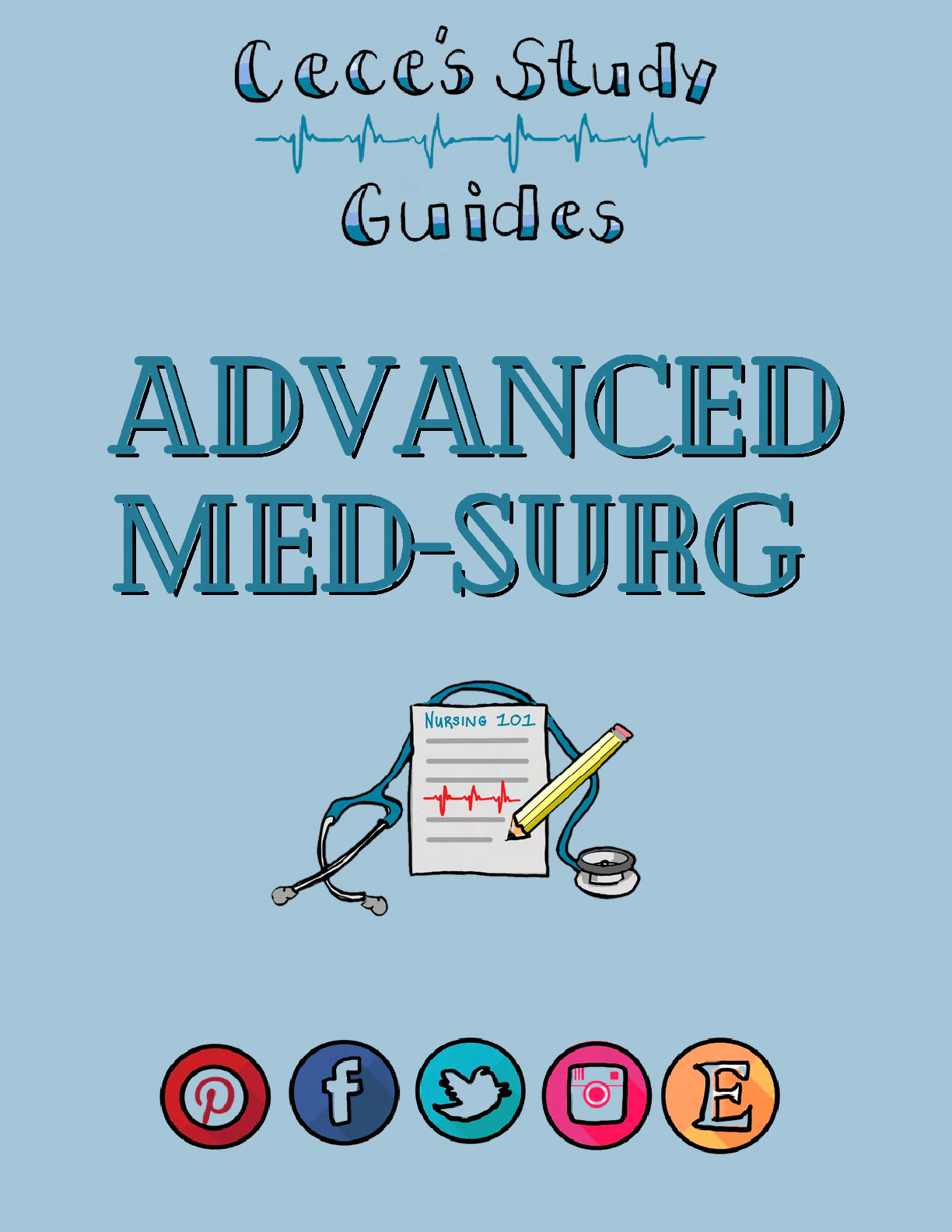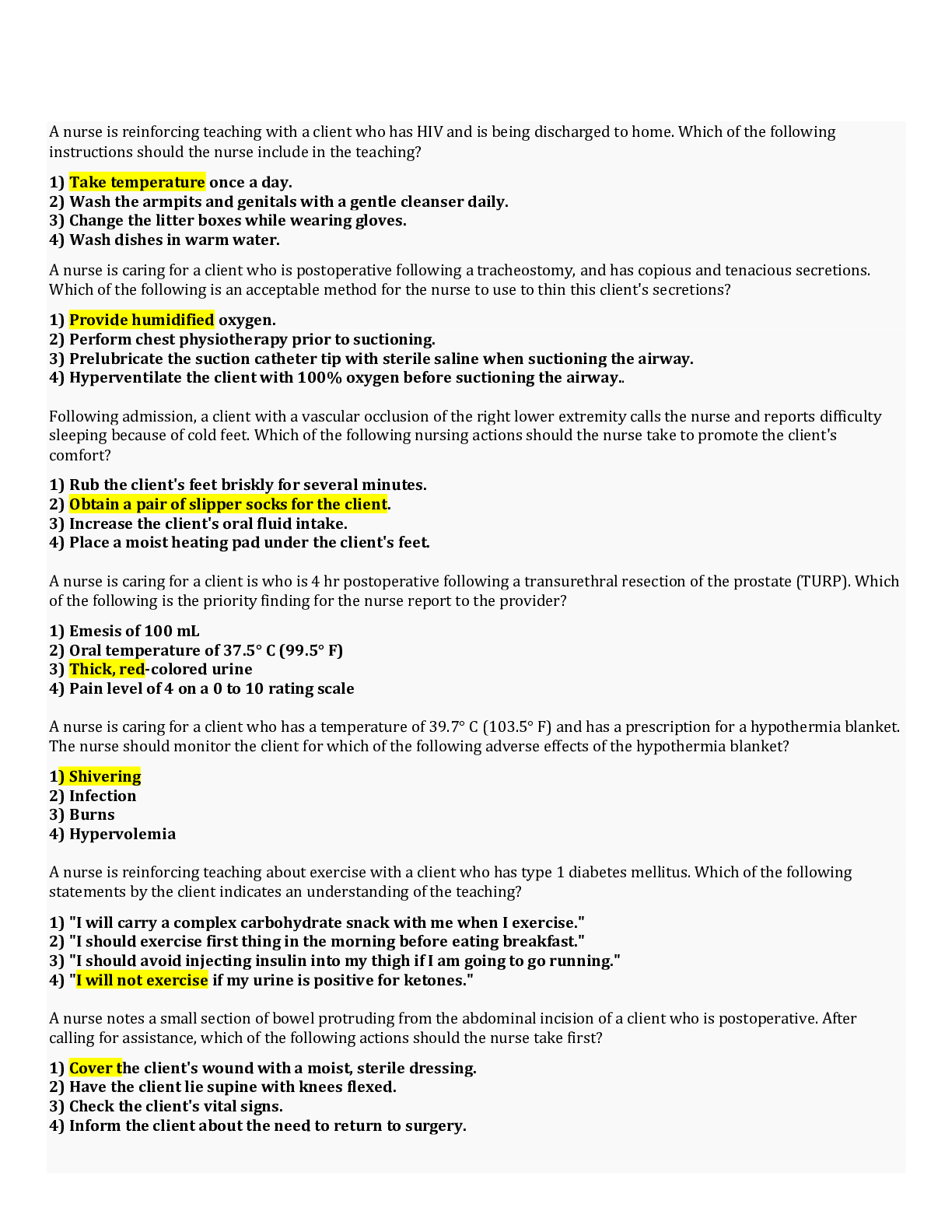*NURSING > STUDY GUIDE > West Coast EMT Block 2 Exam 2022/2023 with complete solutions (All)
West Coast EMT Block 2 Exam 2022/2023 with complete solutions
Document Content and Description Below
A 30-year-old male was rescued after being lost in the woods for approximately 18 hours. The outside temperature is 30°F (-1°C). He is immediately placed in the warmed ambulance, where you perform a... primary assessment. He is unresponsive, pale, and apneic. You should: Select one: A. assess for a carotid pulse for up to 60 seconds. B. apply chemical heat packs to his groin and axillae. C. apply an AED and assess his cardiac rhythm. D. open his airway and give two rescue breaths. - ANSWER A. assess for a carotid pulse for up to 60 seconds. A 31-year-old male was bitten on the leg by an unidentified snake. The patient is conscious and alert and in no apparent distress. Your assessment of his leg reveals two small puncture marks with minimal pain and swelling. In addition to administering oxygen and providing reassurance, further care for this patient should include: Select one: A. elevating the lower extremities and giving antivenin. B. supine positioning, splinting the leg, and transporting. C. applying ice to the wound and transporting quickly. D. transporting only with close, continuous monitoring. - ANSWER B. supine positioning, splinting the leg, and transporting. All of the following terms refer to a body part that is cold but not frozen, EXCEPT: Select one: A. trench foot. B. frostnip. C. frostbite. D. immersion foot. - ANSWER C. frostbite. Burns associated with lightning strikes are typically: Select one: A. full-thickness. B. superficial. C. partial-thickness. D. third-degree. - ANSWER B. superficial. Common signs and symptoms of heat exhaustion include all of the following, EXCEPT: Select one: A. headache. B. hot, dry skin. C. nausea. D. tachycardia. - ANSWER Drowning is MOST accurately defined as: Select one: A. water in the lungs following submersion in water. B. death beyond 24 hours after submersion in water. C. temporary survival after submersion in water. D. death from suffocation after submersion in water. - ANSWER D. death from suffocation after submersion in water. Hypothermia occurs when the core body temperature falls below: Select one: A. 88°F (31°C). B. 98°F (37°C). C. 95°F (35°C). D. 90°F (32°C). - ANSWER C. 95°F (35°C). In contrast to Lyme disease, Rocky Mountain spotted fever: Select one: A. causes painful joint swelling after a few days or weeks. C. may be confused with rheumatoid arthritis. D. presents with flu-like symptoms and a bull's-eye rash. - ANSWER B. can cause paralysis and cardiorespiratory collapse. Most of the serious injuries associated with scuba diving are caused by: Select one: A. alcohol consumption. B. cold water temperature. C. too rapid of an ascent. D. too rapid of a descent. - ANSWER C. too rapid of an ascent. The body's natural cooling mechanism, in which sweat is converted to a gas, is called: Select one: A. convection. B. radiation. C. evaporation. D. conduction. - ANSWER C. evaporation. The EMT must assume that any unwitnessed water-related incident is accompanied by: Select one: A. cold-water immersion. B. an air embolism. C. alcohol intoxication. D. possible spinal injury. - ANSWER D. possible spinal injury. The MOST prominent symptom of decompression sickness is: Select one: A. abdominal or joint pain. B. difficulty with vision. C. tightness in the chest. D. dizziness and nausea. - ANSWER A. abdominal or joint pain. The venom of a black widow spider is toxic to the: Select one: A. cardiovascular system. B. renal system. C. respiratory system. D. nervous system. - ANSWER D. nervous system. When a warm hand is immersed in water that is 70°F (21°C), heat is transferred from the hand to the water through a process called: Select one: A. evaporation. B. conduction. C. radiation. D. convection. - ANSWER B. conduction. Which of the following is an early sign of pit viper envenomation? Select one: A. Signs and symptoms of hypoperfusion B. Syncope and bleeding at distal sites C. General weakness and diaphoresis D. Local swelling and ecchymosis - ANSWER D. Local swelling and ecchymosis Which of the following MOST accurately describes hyperthermia? Select one: A. Heat evaporates a significant amount of body water. B. The body eliminates more heat than it can generate. C. The core body temperature exceeds 99.5°F (37°C). D. The body is exposed to more heat than it can lose. - ANSWER D. The body is exposed to more heat than it can lose. You and your partner respond to a park where several people were reportedly struck by lightning. When you arrive, you find three patients. The first patient is lying supine on the ground; he is unresponsive and does not appear to be breathing. The second patient is ambulatory, appears confused, and is holding his arm against his chest. The third patient is sitting on the ground holding the sides of his head. After calling for backup, you should: Select one: A. assess the unresponsive patient's pulse, begin CPR starting with chest compressions if he is pulseless, and attach the AED as soon as possible. B. immediately begin CPR on the unresponsive patient, but cease resuscitation efforts if there is no response after 5 minutes of treatment. C. focus your initial treatment efforts on the patients who are conscious because the unresponsive patient is likely in irreversible cardiac arrest. D. recognize that the patients who are conscious are at high risk for developing cardiac arrest and quickly assess them for potentially life-threatening injuries. - ANSWER A. assess the unresponsive patient's pulse, begin CPR starting with chest compressions if he is pulseless, and attach the AED as soon as possible. You are transporting a 28-year-old man with a frostbitten foot. The patient's vital signs are stable and he denies any other injuries or symptoms. The weather is treacherous and your transport time to the hospital is approximately 45 minutes. During transport, you should: Select one: A. administer oxygen via a nonrebreathing mask. B. cover his foot with chemical heat compresses. C. protect the affected part from further injury. D. rewarm his foot in 102°F to 104°F (38.9°C to 40°C) water. - ANSWER C. protect the affected part from further injury. You receive a call to a residence for a sick patient. Upon your arrival, you find the patient, a 53-year-old diabetic male, lying down on his front porch. His wife tells you that he had been mowing the lawn in the heat for the past 3 hours. The patient is confused and has hot, moist skin. His pulse is weak and thready, and his blood pressure is 90/50 mm Hg. You should: Select one: A. administer one tube of oral glucose and reassess his mental status. B. perform a head-to-toe assessment and look for signs of trauma. C. place him in a sitting position and have him drink 1 L of water. D. load him into the ambulance and begin rapid cooling interventions. - ANSWER D. load him into the ambulance and begin rapid cooling interventions. You respond to a local lake where a diver complains of difficulty breathing that occurred immediately after rapidly ascending from a depth of approximately 30 feet. On assessment, you note that he has cyanosis around his lips and has pink froth coming from his nose and mouth. You should: Select one: A. suction his mouth and nose, keep him supine and elevate his legs to prevent air bubbles from entering his brain, administer high-flow oxygen, and transport to a hyperbaric chamber. B. place him in a semi-sitting position, suction his mouth and nose, apply a continuous positive airway pressure (CPAP) device, and transport to the closest emergency department. C. suction his mouth and nose, apply high-flow oxygen, monitor the patient's breath sounds for a pneumothorax, and contact medical control regarding transport to a recompression facility. D. position him supine with his head elevated 30°, suction his mouth and nose, hyperventilate him with a bag-valve mask, and contact medical control for further guidance. - ANSWER C. suction his mouth and nose, apply high-flow oxygen, monitor the patient's breath sounds for a pneumothorax, and contact medical control regarding transport to a recompression facility. Ten days after treating a 34-year-old patient with tuberculosis, you are given a tuberculin skin test, which yields a positive result. This MOST likely indicates that: Select one: A. the disease is dormant in your body, but will probably never cause symptoms. B. you are actively infected with tuberculosis and should be treated immediately. C. you were exposed to another infected person prior to treating the 34-year-old patient. D. you contracted the disease by casual contact instead of exposure to secretions. - ANSWER C. you were exposed to another infected person prior to treating the 34-year-old patient. After sizing up the scene of a patient with a possible infectious disease, your next priority should be to: Select one: A. contact medical control. B. notify law enforcement. C. quickly access the patient. D. take standard precautions. - ANSWER D. take standard precautions. An infectious disease is MOST accurately defined as: Select one: A. any disease that enters the body via the bloodstream and renders the immune system nonfunctional. B. the invasion of the human body by a bacterium that cannot be destroyed by antibiotics or other drugs. C. a medical condition caused by the growth and spread of small, harmful organisms within the body. D. a disease that can be spread from one person or species to another through a number of mechanisms. - ANSWER C. a medical condition caused by the growth and spread of small, harmful organisms within the body. Assessment of the medical patient is usually focused on the _________. Select one: A. nature of illness B. field diagnosis C. associated symptoms D. medical history - ANSWER A. nature of illness Hepatitis B is more virulent than hepatitis C, which means that it: Select one: A. is a more contagious type of disease. B. has a greater ability to produce disease. C. leads to chronic infection after exposure. D. is less resistant to treatment. - ANSWER B. has a greater ability to produce disease. In 2009, the H1N1 virus accounted for over 200,000 deaths worldwide in the form of the swine flu. In 1919, a similar outbreak of the H1N1 occurred in the form of the Spanish flu. Starting in Kansas City, the virus spread rapidly worldwide, claiming up to 50 million lives. These are both examples of: Select one: A. epidemics. B. parasitic infection. C. uncontrolled outbreaks. D. pandemics. - ANSWER D. pandemics. In which of the following situations would it be MOST appropriate to utilize an air medical transportation service? Select one: A. 29-year-old woman who is 18 weeks pregnant, has light vaginal bleeding, and stable vital signs B. 50-year-old conscious woman with severe nausea and vomiting, fever, and chills of 3 days' duration C. 43-year-old man experiencing a heart attack, and the closest appropriate hospital is 15 minutes away D. 61-year-old man with signs and symptoms of a stroke and a ground transport time of 50 minutes - ANSWER D. 61-year-old man with signs and symptoms of a stroke and a ground transport time of 50 minutes It is especially important to assess pulse, sensation, and movement in all extremities as well as pupillary reactions in patients with a suspected ___________ problem. Select one: A. endocrine B. respiratory C. cardiac D. neurologic - ANSWER D. neurologic Most patients with an infectious disease will have _________. Select one: A. a low blood glucose level B. abdominal pain C. seizures D. a fever - ANSWER D. a fever Most treatments provided in the prehospital setting are intended to _________. Select one: A. reduce the need for transport to the hospital B. confirm the patient's diagnosis C. address the patient's symptoms D. correct the patient's underlying problem - ANSWER C. address the patient's symptoms The BEST way to prevent infection from whooping cough is to: Select one: A. routinely place a surgical mask on all respiratory patients. B. ask all patients if they have recently traveled abroad. C. get vaccinated against diphtheria, tetanus, and pertussis. D. wear a HEPA mask when treating any respiratory patient. - ANSWER C. get vaccinated against diphtheria, tetanus, and pertussis. The determination of whether a medical patient is a high-priority or low-priority transport is typically made: Select one: A. as soon as the patient voices his or her chief complaint. B. after the primary assessment has been completed. C. upon completion of a detailed secondary assessment. D. once the patient's baseline vital signs are known. - ANSWER B. after the primary assessment has been completed. When assessing a patient with a medical complaint, which of the following would MOST likely reveal the cause of the problem? Select one: A. Baseline vital signs B. Index of suspicion C. Medical history D. Primary assessment - ANSWER C. Medical history When caring for a patient with an altered mental status and signs of circulatory compromise, you should: Select one: A. perform a detailed secondary assessment prior to transporting the patient. B. have a paramedic unit respond to the scene if it is less than 15 minutes away. C. limit your time at the scene to 10 minutes or less, if possible. D. transport immediately and begin all emergency treatment en route to the hospital. - ANSWER C. limit your time at the scene to 10 minutes or less, if possible. When forming your general impression of a patient with a medical complaint, it is important to remember that: Select one: A. most serious medical conditions do not present with obvious symptoms. B. it is during the general impression that assessment of the ABCs occurs. C. the conditions of many medical patients may not appear serious at first. D. the majority of medical patients you encounter are also injured. - ANSWER C. the conditions of many medical patients may not appear serious at first. Which of the following conditions is NOT categorized as a psychiatric condition? Select one: A. Alzheimer disease B. Depression C. Schizophrenia D. Substance abuse - ANSWER D. Substance abuse Which of the following is bacterium resistant to most antibiotics and causes skin abscesses? Select one: A. Whooping cough B. MRSA C. H1N1 D. Avian flu - ANSWER B. MRSA Which of the following patients is at greatest risk for complications caused by the influenza virus? Select one: A. 50-year-old woman moderate obesity B. 68-year-old woman with type 2 diabetes C. 12-year-old child with a fractured arm D. 39-year-old man with mild hypertension - ANSWER B. 68-year-old woman with type 2 diabetes You and your EMT partner arrive at the residence of a 50-year-old man who complains of weakness. Your primary assessment reveals that he is critically ill and will require aggressive treatment. The closest hospital is 25 miles away. You should: Select one: A. administer oxygen via nonrebreathing mask and obtain as much of his medical history as possible. B. manage all threats to airway, breathing, and circulation and consider requesting an ALS unit. C. load him into the ambulance, begin transport, and perform all treatment en route to the hospital. D. perform a detailed secondary assessment, assess his vital signs, and then transport rapidly. - ANSWER B. manage all threats to airway, breathing, and circulation and consider requesting an ALS unit. You are attending to a 27-year-old male driver of a car. According to his passenger, the patient had been acting strangely while driving, then slumped forward against the steering wheel, apparently unconscious. The car drove off the road and struck a telephone pole. The patient remains unconscious, and physical assessment reveals only a large hematoma on his right forehead with no other physical signs. Your patient is a diabetic who had been under a lot of stress lately and may have missed meals. This is an example of a: Select one: A. combination of a psychiatric and trauma emergency. B. medical emergency. C. trauma emergency. D. combination of a medical and trauma emergency. - ANSWER D. combination of a medical and trauma emergency. "PASTE" is an alternate assessment tool for ___________. Select one: A. respiratory patients B. seizure patients C. stroke patients D. cardiac patients - ANSWER A. respiratory patients A 30-year-old male presents with acute shortness of breath, widespread hives, and facial swelling. He denies any past medical history and takes no medications. During your assessment, you hear wheezing over all the lung fields. His blood pressure is 90/50 mm Hg and his heart rate is 110 beats/min. In addition to giving him high-flow oxygen, the MOST important treatment for this patient is: Select one: A. epinephrine. B. a beta-antagonist. C. albuterol. D. an antihistamine. - ANSWER A. epinephrine. A 59-year-old male with a history of emphysema complains of an acute worsening of his dyspnea and pleuritic chest pain following a forceful cough. Your assessment reveals that he has a barrel-shaped chest, unilaterally diminished breath sounds, and tachycardia. What is the MOST likely cause of this patient's condition? Select one: A. Spontaneous pneumothorax B. Exacerbation of his COPD C. Acute pulmonary embolism D. Rupture of the diaphragm - ANSWER A. Spontaneous pneumothorax A pleural effusion is MOST accurately defined as: Select one: A. fluid accumulation outside the lung. B. diffuse collapsing of the alveoli. C. a unilaterally collapsed lung. D. a bacterial infection of the lung tissue. - ANSWER A. fluid accumulation outside the lung. Asthma is caused by a response of the: Select one: A. immune system. B. cardiovascular system. C. endocrine system. D. respiratory system. - ANSWER A. immune system. [Show More]
Last updated: 1 year ago
Preview 1 out of 74 pages
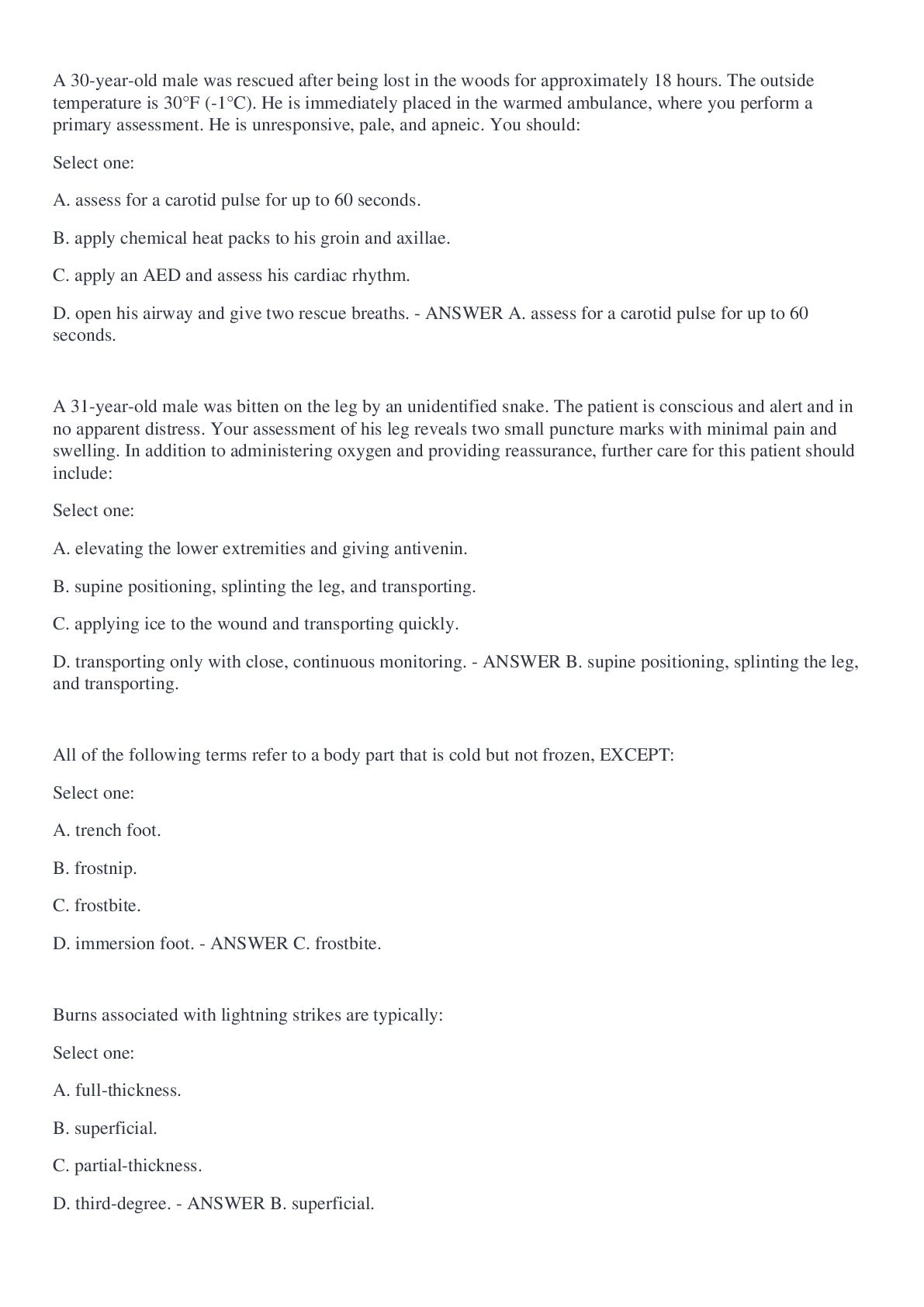
Reviews( 0 )
Document information
Connected school, study & course
About the document
Uploaded On
Jul 20, 2022
Number of pages
74
Written in
Additional information
This document has been written for:
Uploaded
Jul 20, 2022
Downloads
0
Views
76

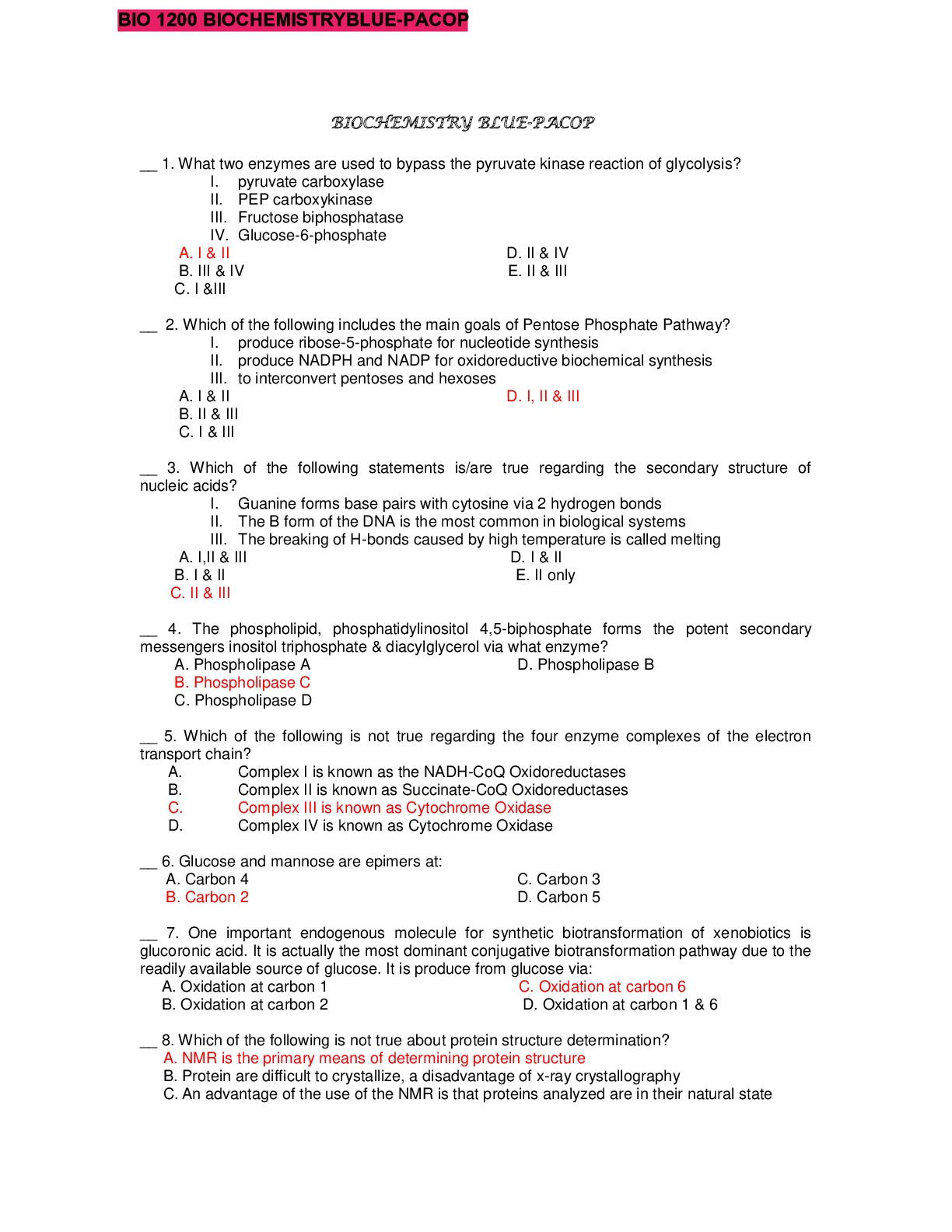
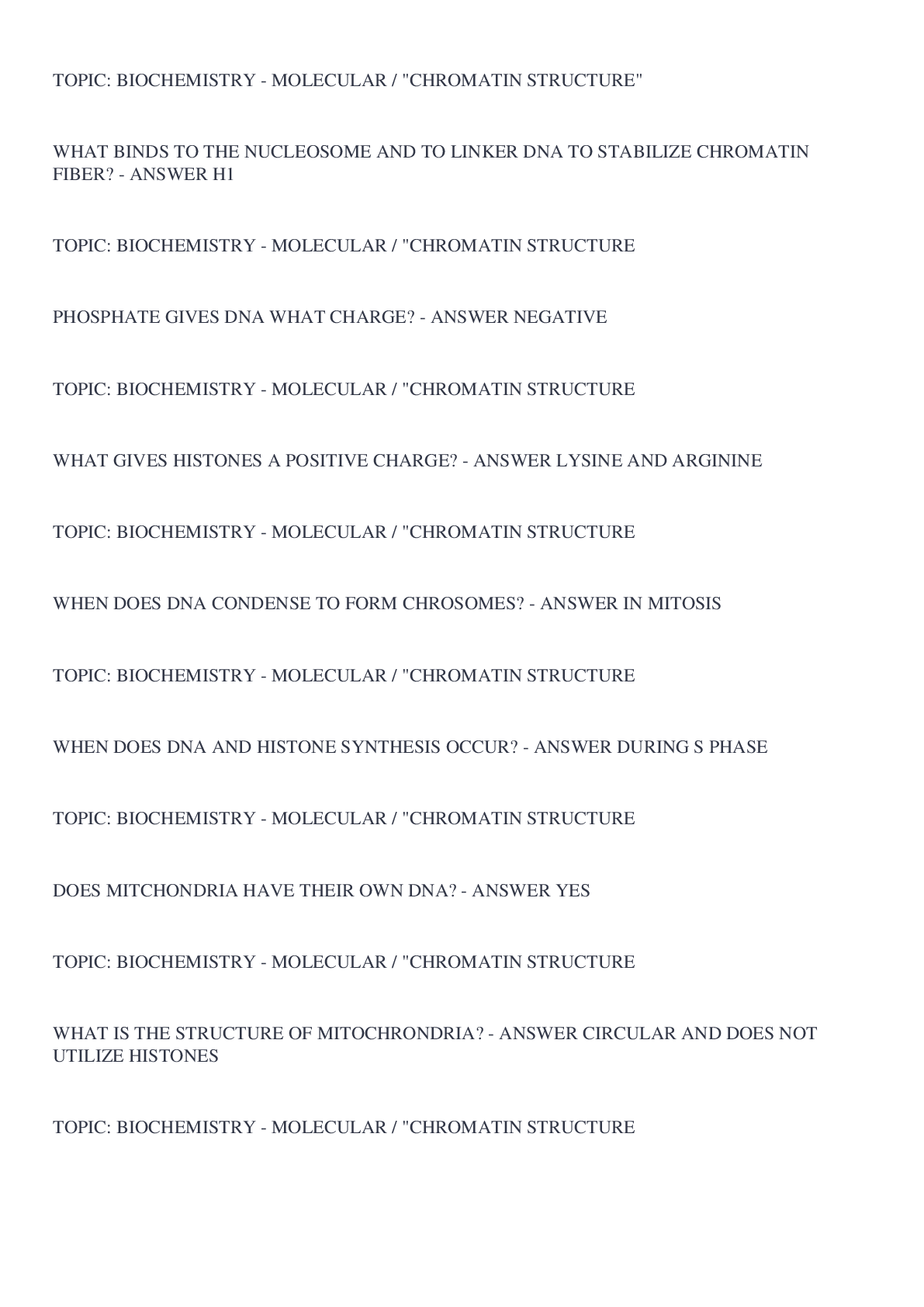
.png)
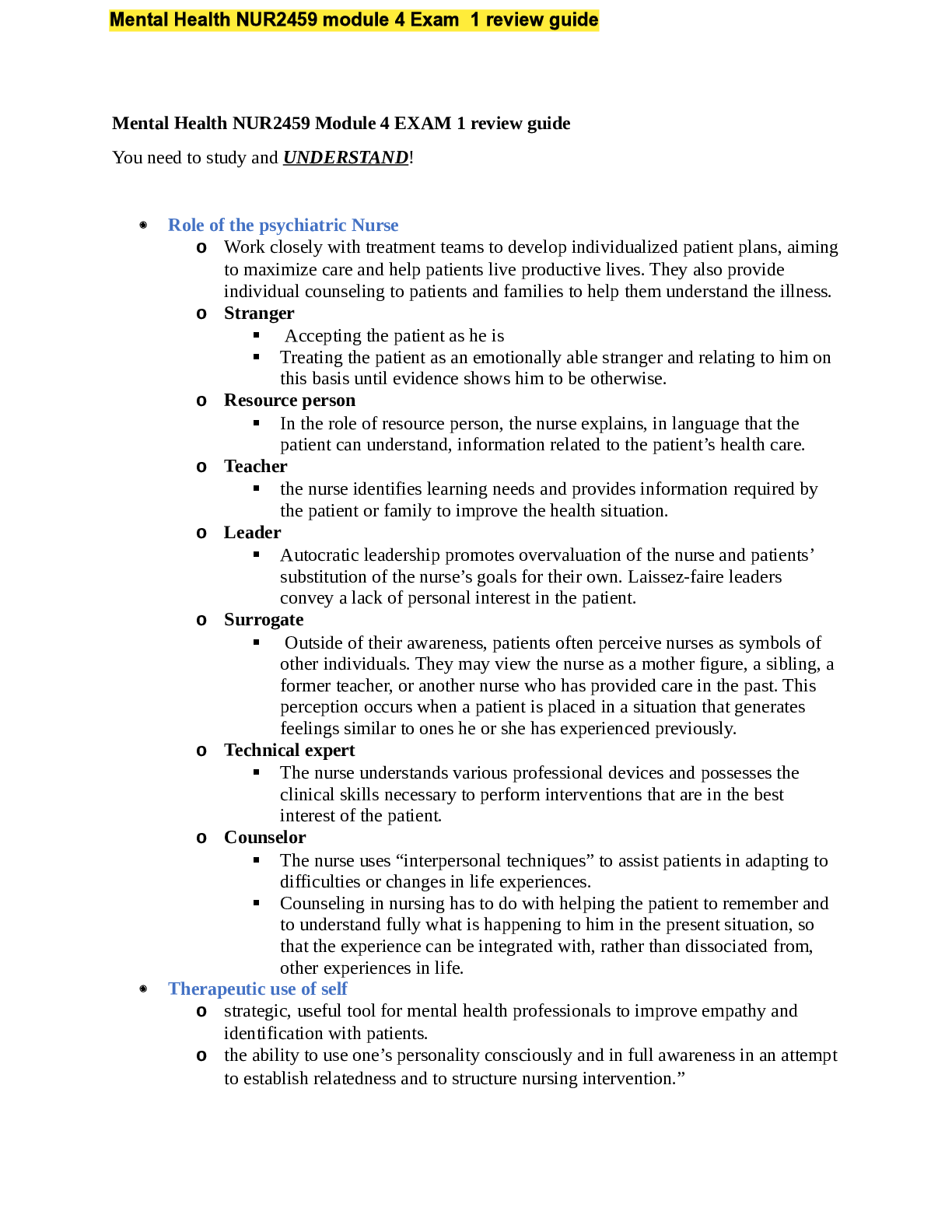
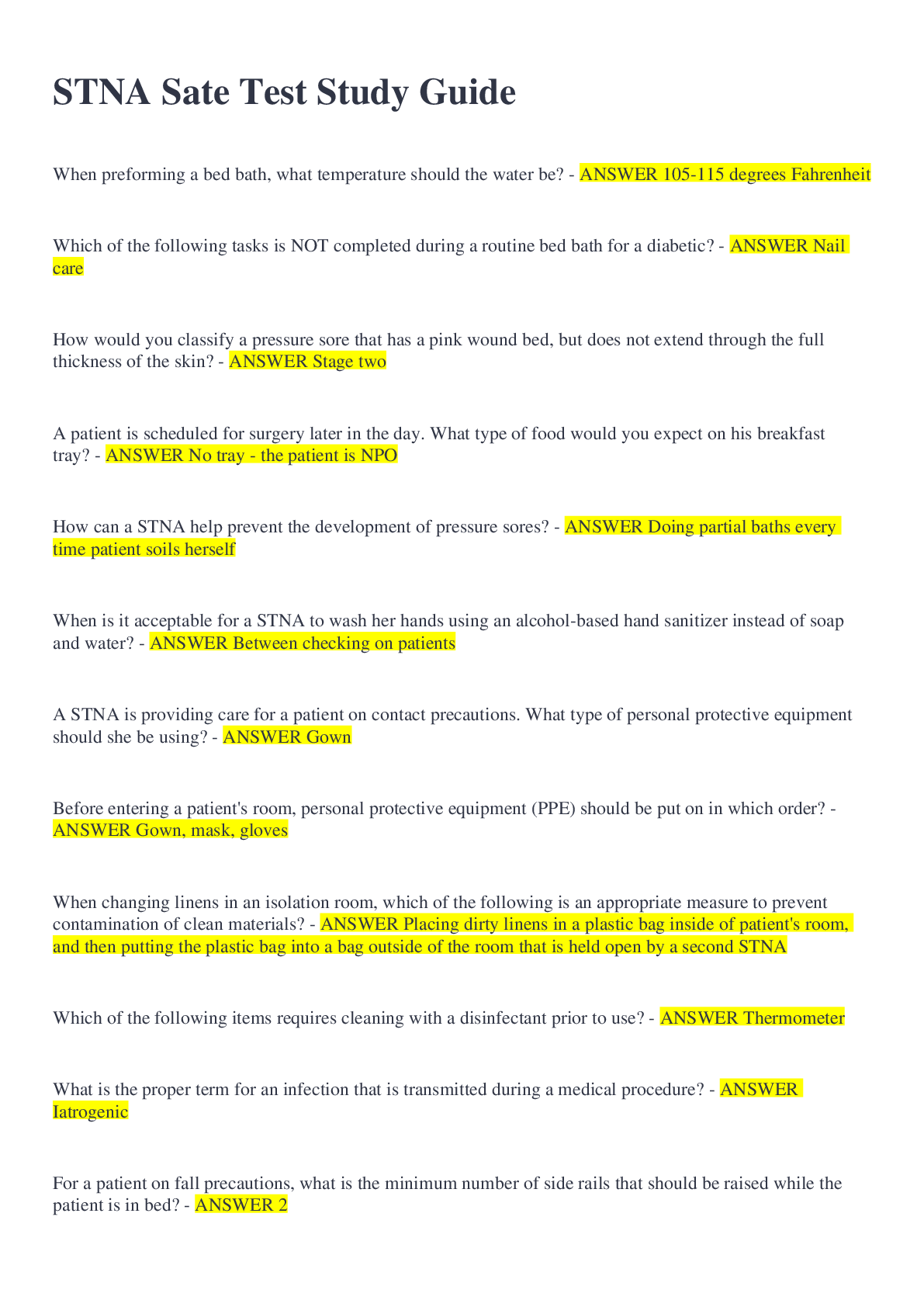
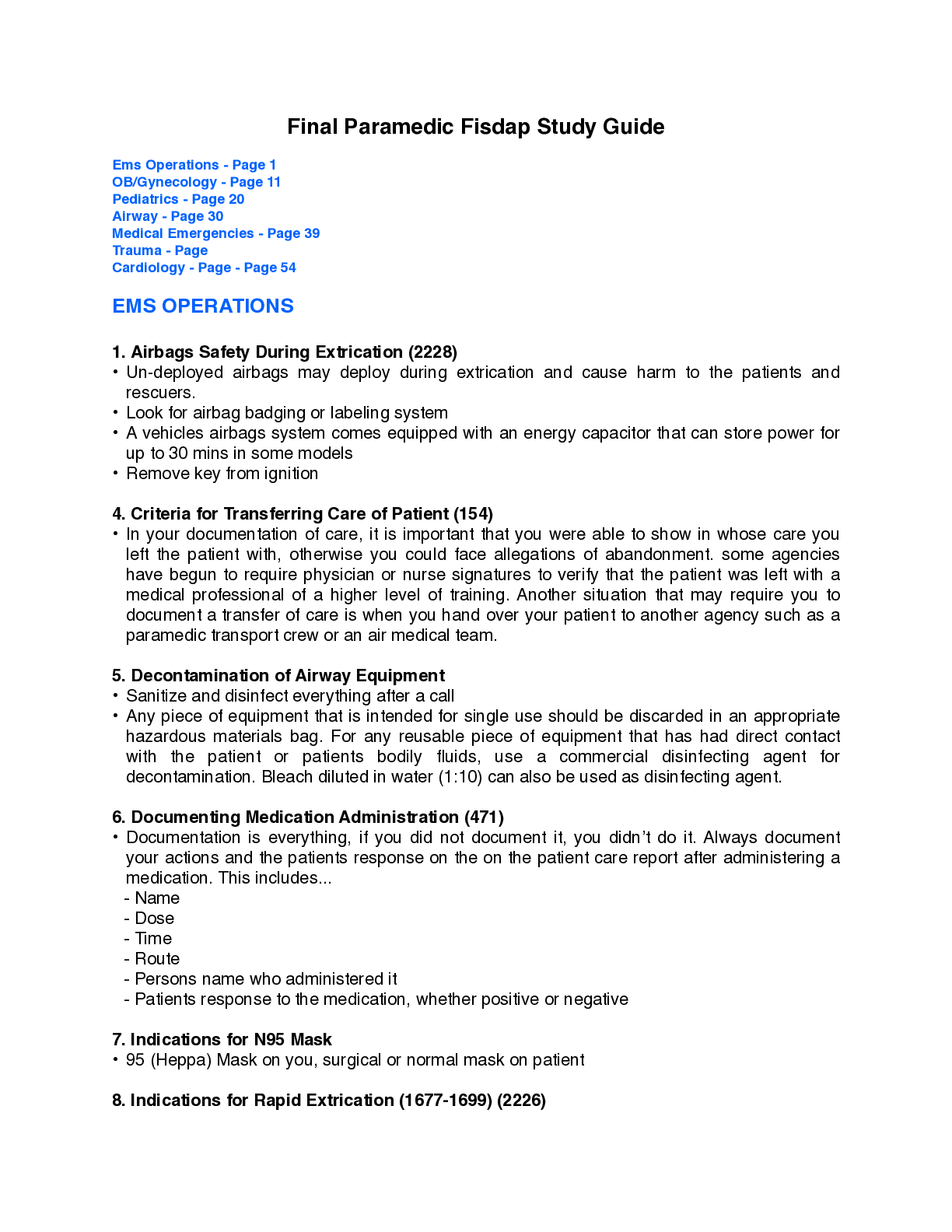
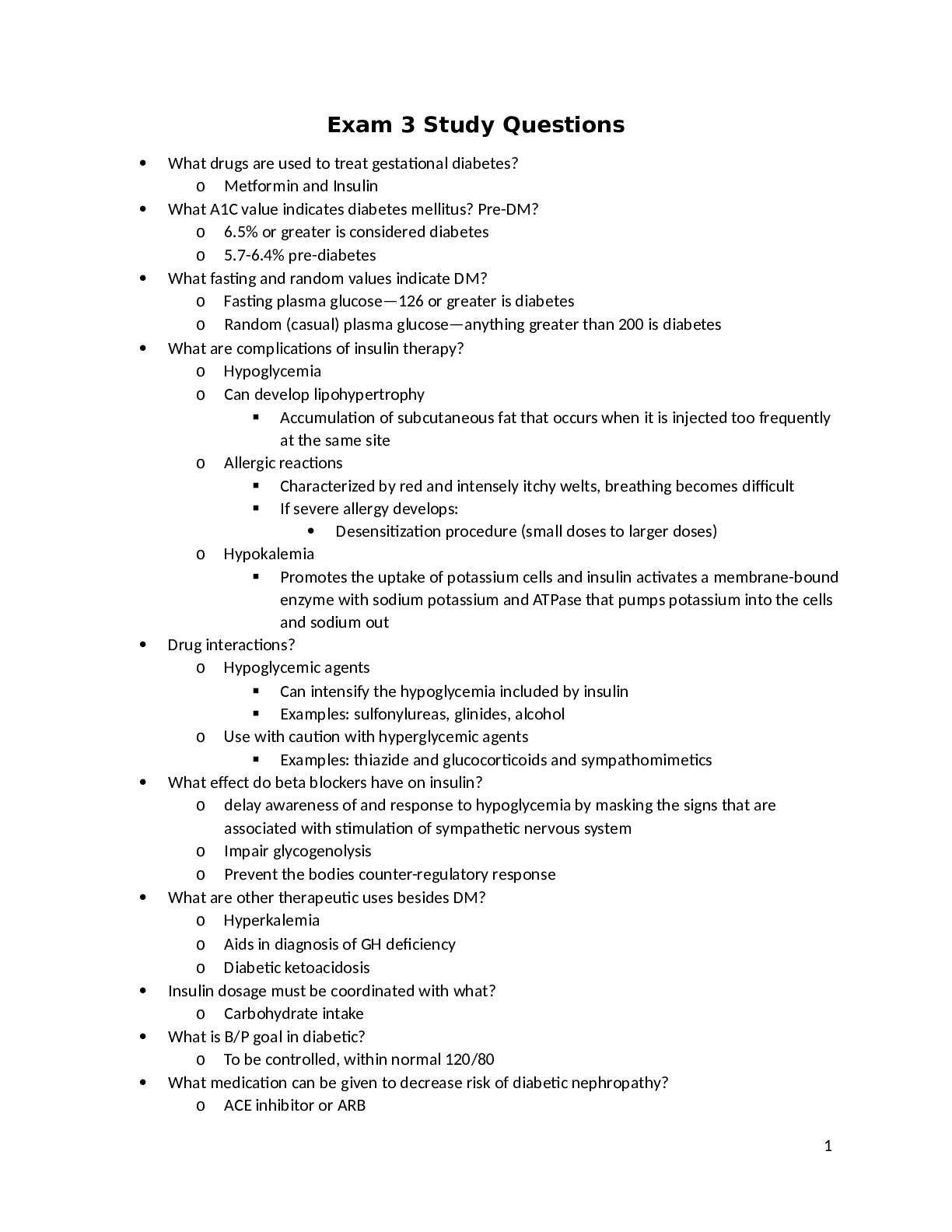
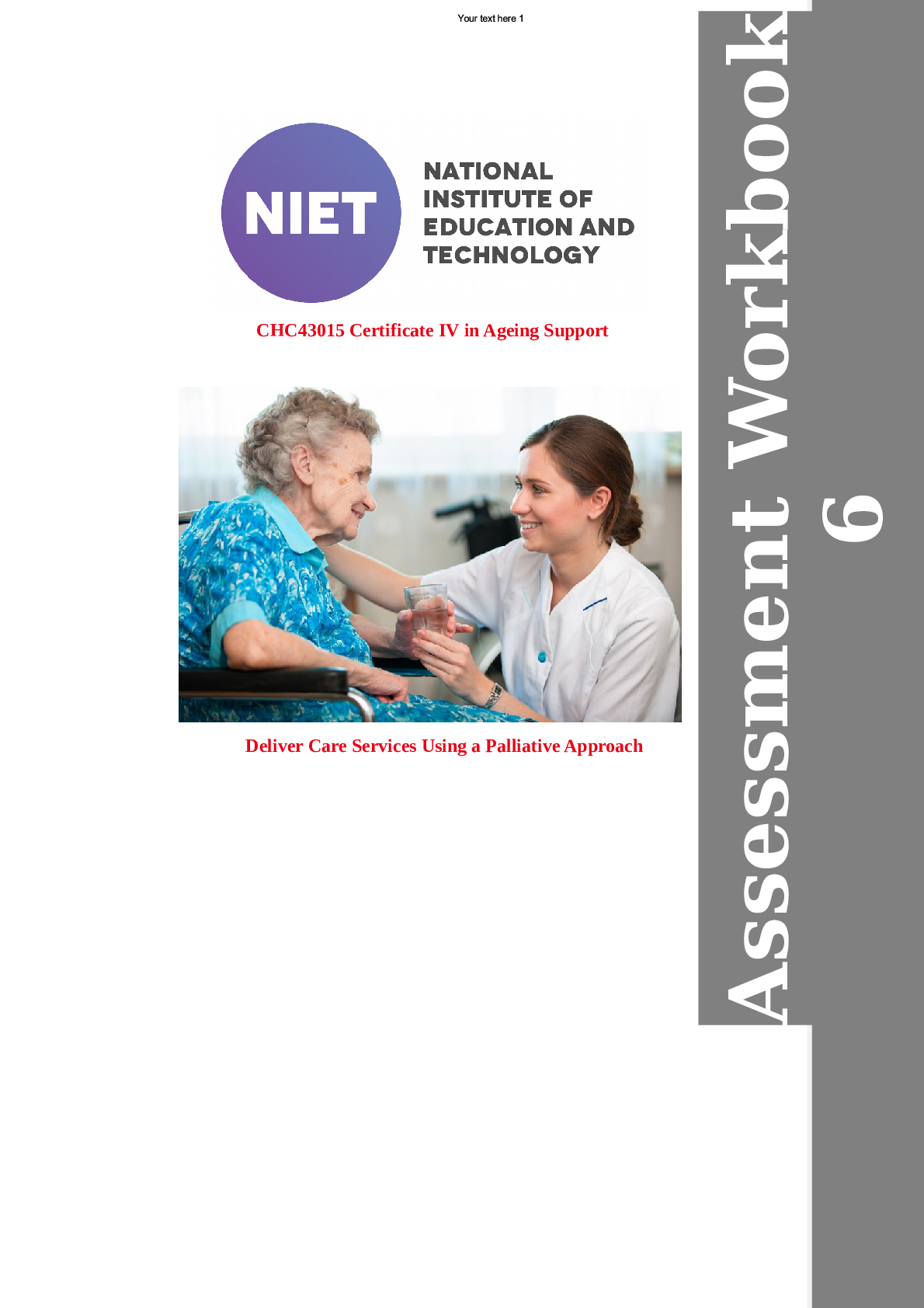

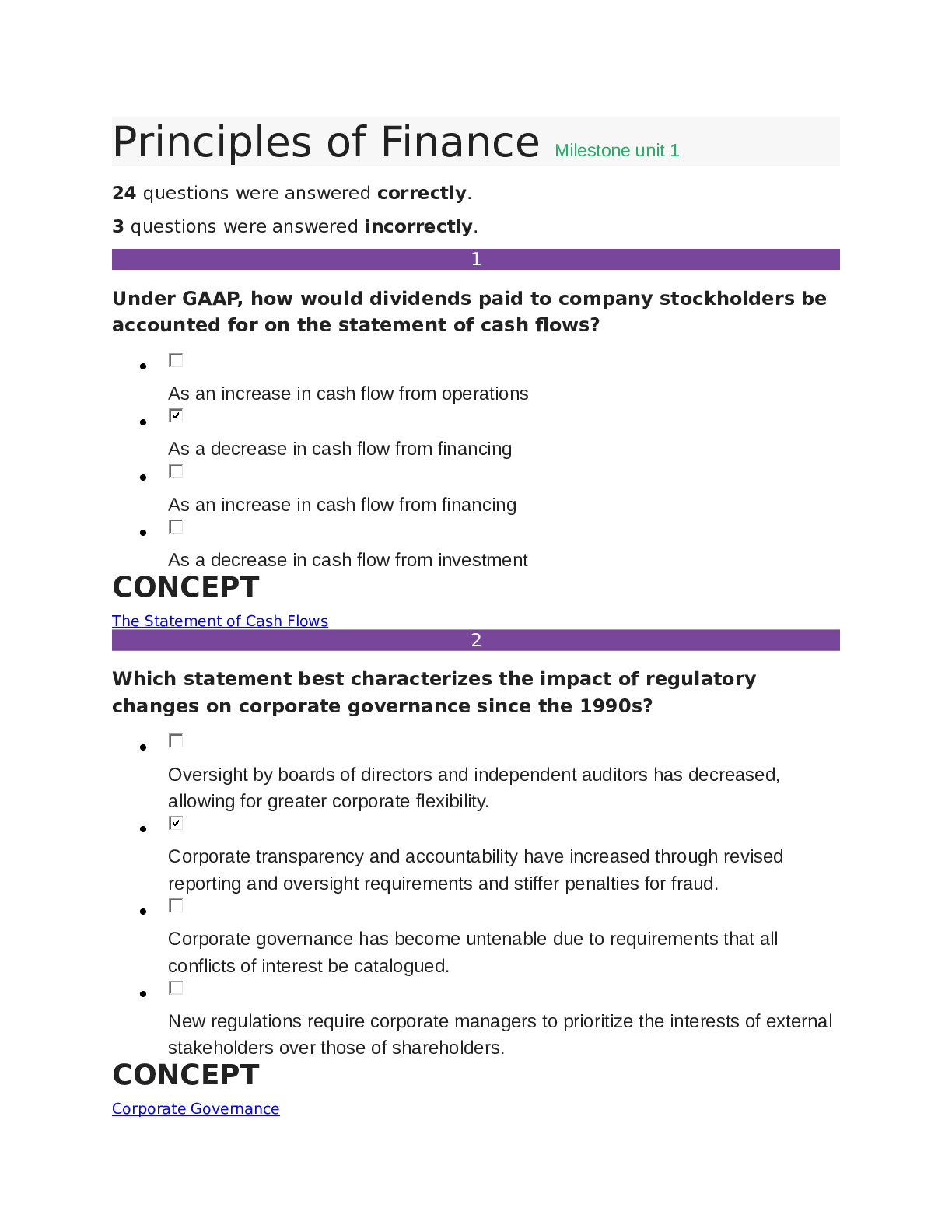
.png)
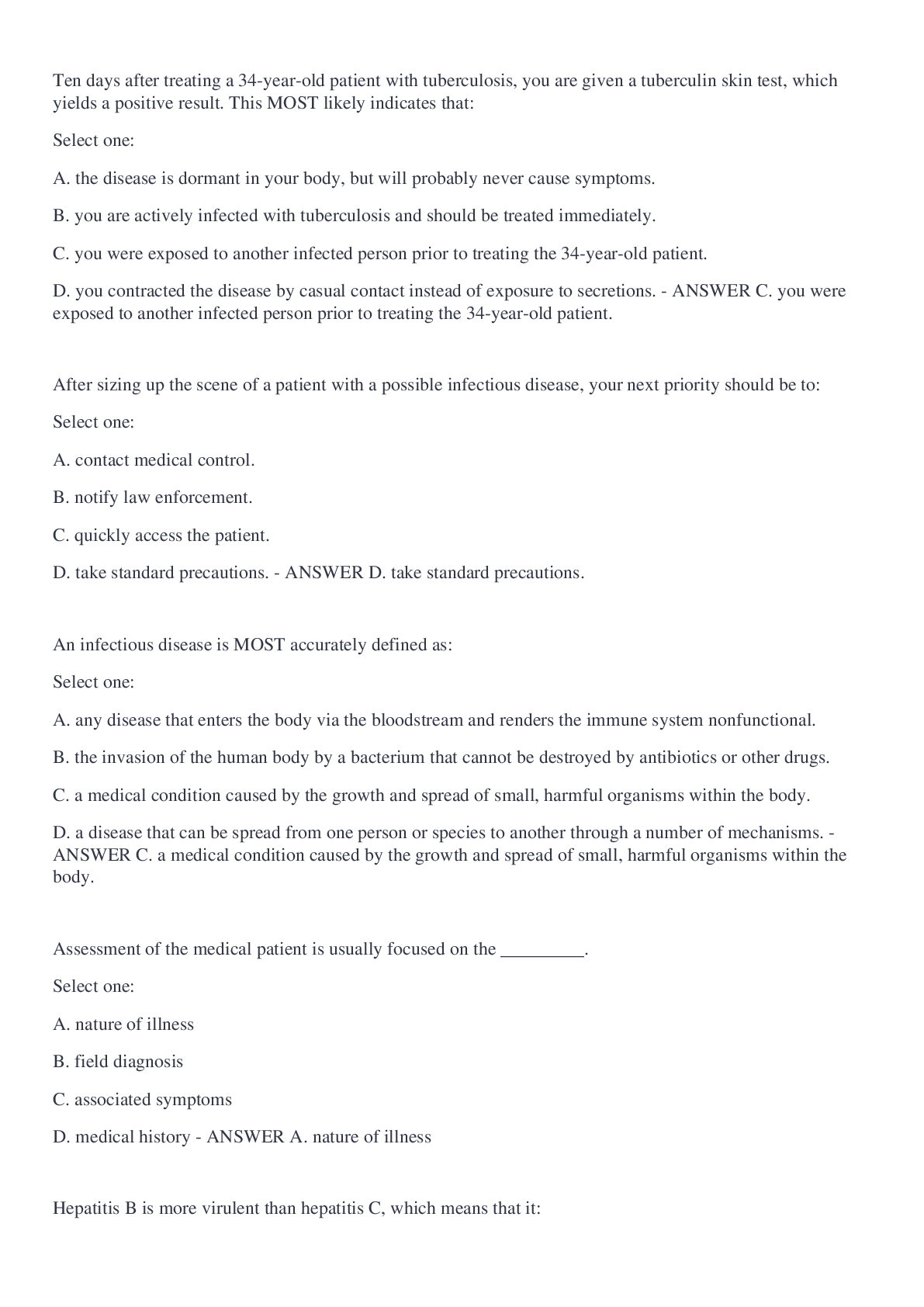
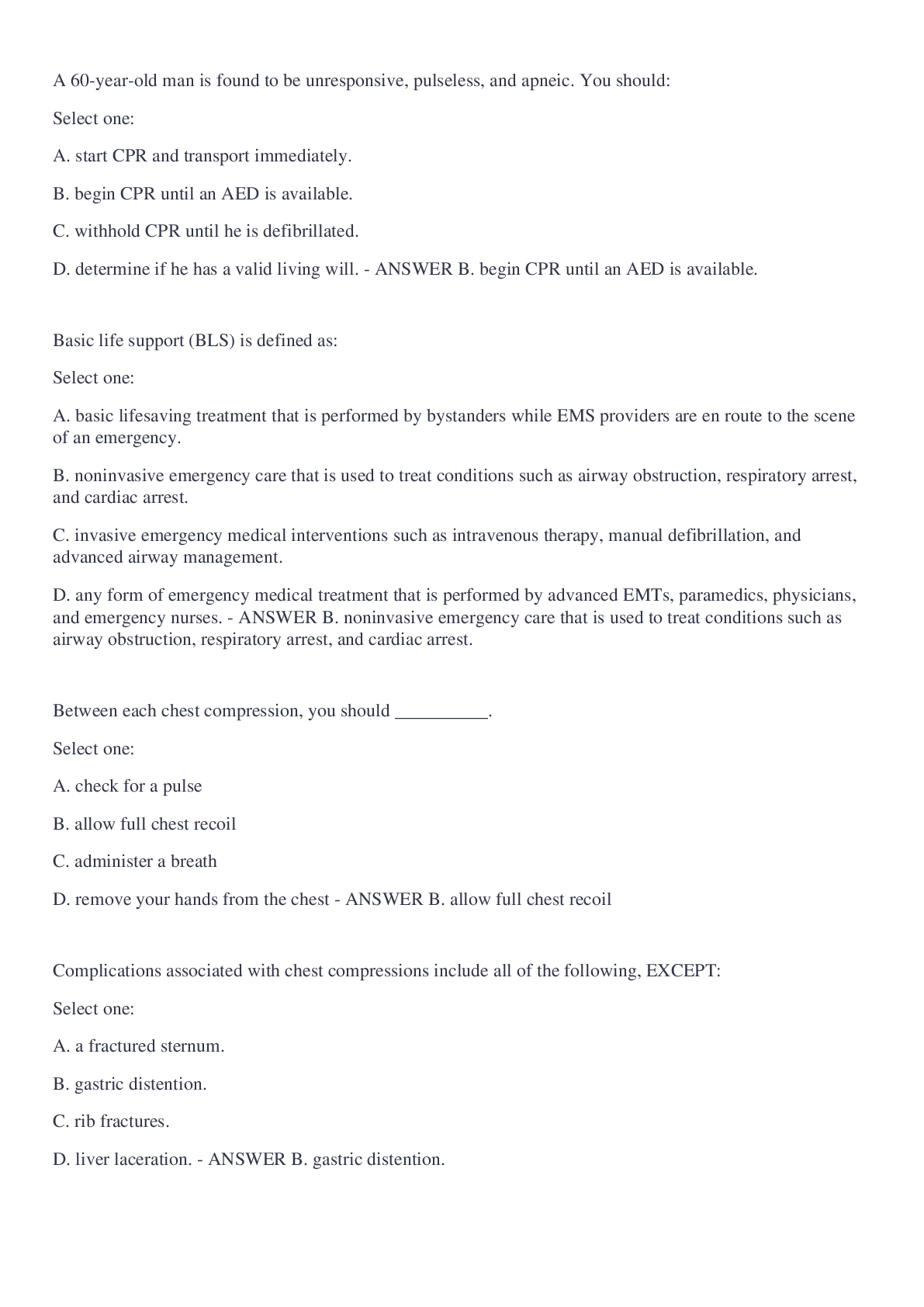
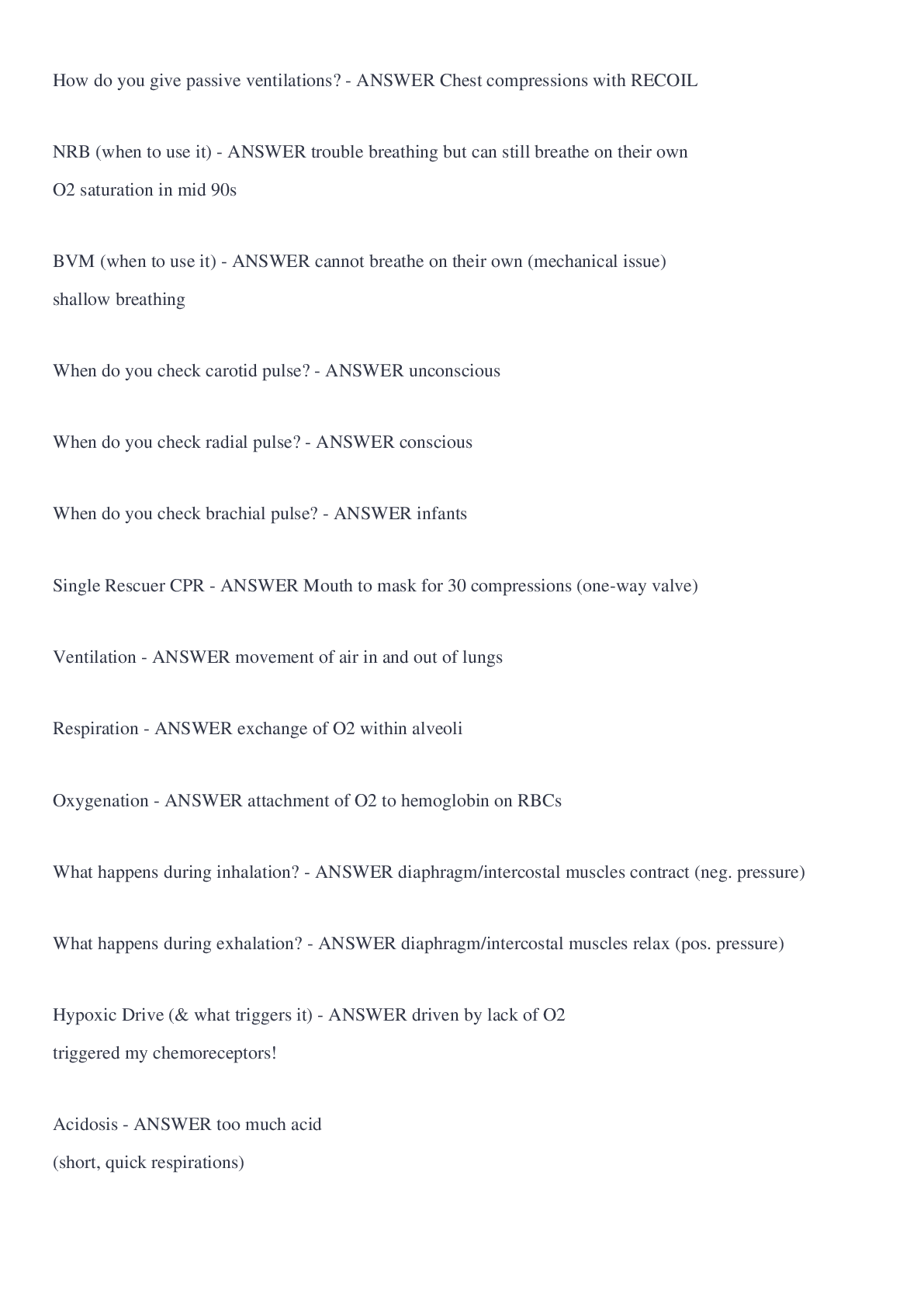
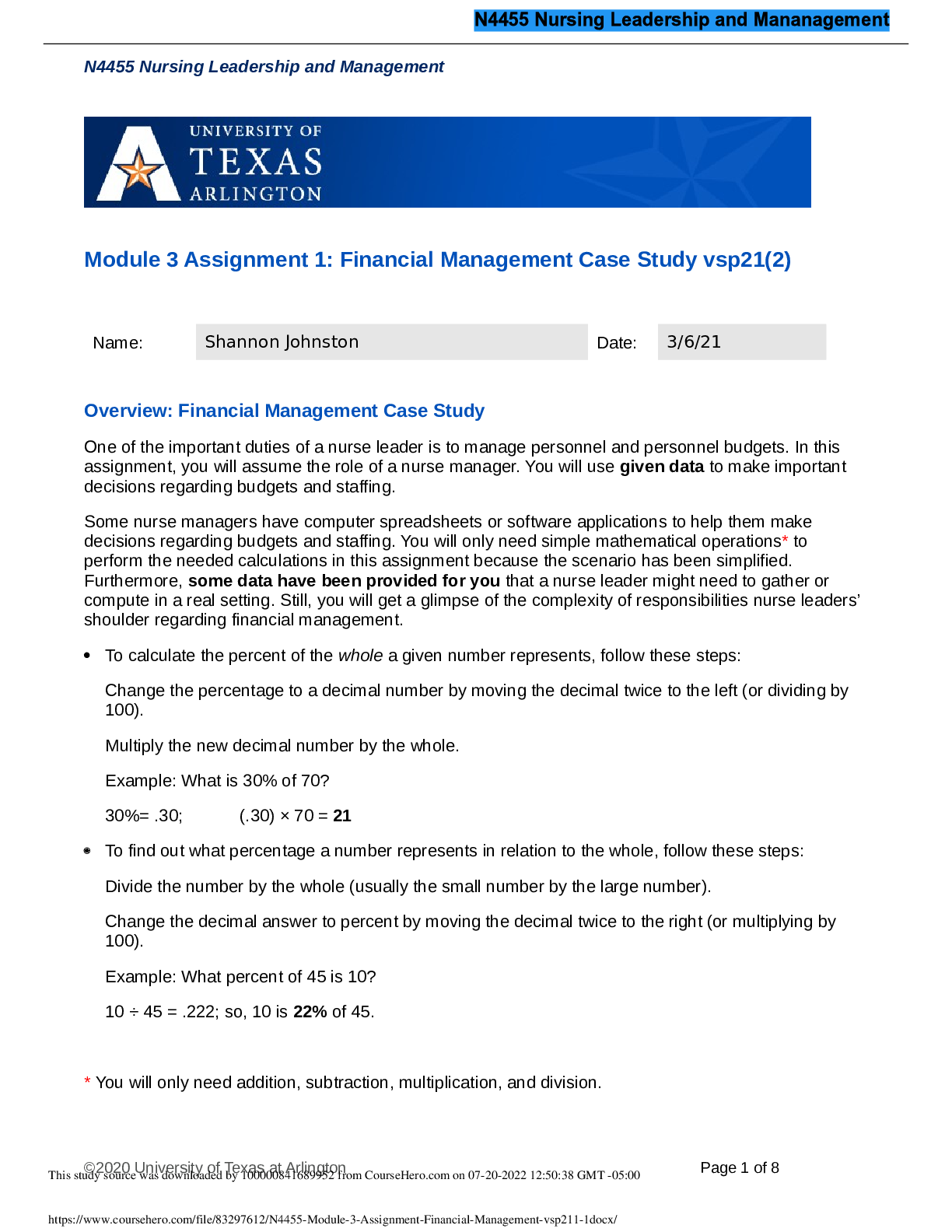








.png)

